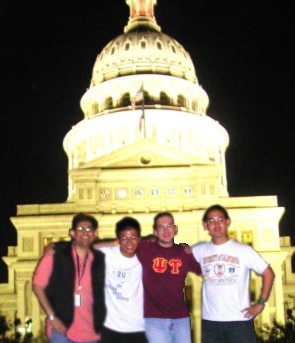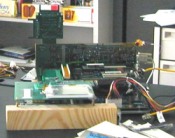Hacking Linux for Fun and Profit at IBM
David Eger GT '03

|
|
Anand, David, David (Random), and Ron Woan at the Capitol of Texas |
In the Spring of 2001, I had met a recruiter by the name of Ron Woan at an ACM meeting on Georgia Tech campus. He gave a talk on setting up networks to do specific jobs - where to put your databases and web servers, how to arrange the servers for various security tasks, and trying to build enough redundancy into your network so that there aren't any outages. Having been on the core team responsible for the 1996 Olympics web site, he knew this stuff from personal experience; and that was one of the things that attracted me to the internship program - that they had bothered to send a technical person who really knew his stuff. The job description didn't hurt either: Take a prototype technology - an unreleased System-On-a-Chip - and make Linux do something neat with it.
A System-On-a-Chip is basically what the name implies. Take a microprocessor along with most of the things it needs to work with the outside world - an Ethernet controller, a PCMCIA controller, input controllers, a video controller, an interrupt chip, and maybe a USB controller, and shrink it all down into one tiny silicon package. This sort of device is can be general purpose or very specialized, and can be put into a wide range of portable electronics, from mobile phones to PDAs. The kernel is the piece of software that makes the hardware work.

|
| Our toys / Bishop's mad skills |

|
|
The Earl Intern Team Matthew Helsley - Touch Panel Benjamin Li - PCMCIA, Flash Boot Benjamin Gigot - Business Case David Eger - Video |
Chasing down obscure hardware and software bugs and eating sushi and Chinese food was life for my team on many a freezing summer night. Yes freezing. Yes, in Texas. In the land where it was over a hundred degrees for a month on end. Our work was in the lab on the sixth floor of building 906. The lab, formerly a computer room, had three industrial sized air conditioners with two settings: Off, and Freezing. So while the rest of the world sweated out the summer nights, we brought blankets and poked around at our toy machines, trying to make them show pretty colors and do something neat when we poked at their screens.
The chip, code-named "Earl" by the playful folks at Austin Research Lab was unveiled to the world on March 13, 2002 at the Embedded Systems Conference in San Francisco. It was running a 2.4.17 Linux kernel booted from flash, Qt/Embedded running on the framebuffer with the touchpanel, and an MPEG-4 video player streaming data from an IBM microdrive. It also featured dynamic voltage and frequency scaling - an exciting power-saving technology in the embedded space which gives great hope of extending battery life.